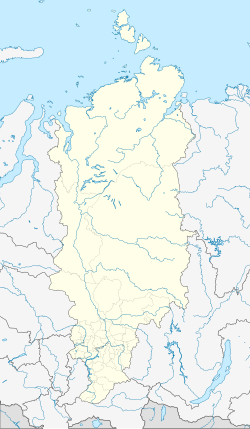Shushenskoye
| Urban-type settlement
Shushenskoye
Шушенское
|
||||||||||||||||||||||||||||||||
|
||||||||||||||||||||||||||||||||
|
||||||||||||||||||||||||||||||||
| List of large settlements in Russia | ||||||||||||||||||||||||||||||||
Shushenskoye ( Russian Шу́шенское ) is an urban-type settlement in the Krasnoyarsk region in Siberia , Russia with 17,513 inhabitants (as of October 14, 2010).
geography
Shushenskoye is 85 km southeast of Abakan , the capital of the autonomous neighboring republic of Khakassia in the Minussinsk Basin at the foot of the West Sayan, not far from the mouth of the Schusch river, which gives it its name, into the Yenisei .
The dam of the Sajano-Schuschensk reservoir, named after the mountains and location, with one of the world's largest hydropower plants with a capacity of 6400 megawatts, has been in operation about 70 km upstream since 1978.
Shushenskoye is the administrative center of the raion of the same name .
history
The village of Shushenskoye was founded by Cossacks as a fortified settlement in 1728 (according to other sources in 1744). Mentioned in 1771 by the German explorer Peter Simon Pallas .
In the 19th century it also served as a place of political exile , for example for Decembrists , participants in the Polish November uprising of 1830 and Narodniki . From May 8, 1897 to January 29, 1900, Lenin was initially exiled alone in Shushenskoye. From May 7, 1898, his wife Nadezhda Krupskaja and her mother joined them. For this reason, in the Soviet era , the place became a "place of pilgrimage" for over a hundred thousand people every year.
In 1960 urban-type settlement status was given.
Population development
| year | Residents |
|---|---|
| 1897 | 1,382 |
| 1959 | 5,384 |
| 1970 | 14,073 |
| 1979 | 16,704 |
| 1989 | 19,289 |
| 2002 | 19,067 |
| 2010 | 17,513 |
Note: census data
Culture and sights
In 1930, Lenin's house from the time of his exile was converted into a museum. In 1970, on the occasion of Lenin's 100th birthday, it was expanded into an open-air museum spanning six and a half hectares of land . In addition to the houses in which Lenin and his family lived, you can also see an old grocer, an inn, a police station and a prison from around 1900.
This museum still exists today, but the focus is now on Siberian architecture and way of life. Only one house is dedicated to Lenin; here, among other things, his desk can be admired.
One of the two parts of the Shushensky Bor National Park extends south and south-east of the town . The park administration is also located in Shushenskoye.
Since 2003 the annual festival of ethnic music "Ring of Sajan" ("Sajanskoje kolzo") has been taking place in Shushenskoye .
economy
In addition to tourism, there are mainly food industry companies in Shushenskoye.
The place is connected to the nearest railway station Minussinsk on the South Siberian Railway Abakan - Taischet and the Russian road network via a 60 km long fixed road connection .
A small civilian airfield about 6 km northeast of the town ( ICAO code Unau) in Kazantsevo, Shushensky District, Krasnoyarsk Krai is currently not served regularly.
Individual evidence
- ↑ a b Itogi Vserossijskoj perepisi naselenija 2010 goda. Tom 1. Čislennostʹ i razmeščenie naselenija (Results of the All-Russian Census 2010. Volume 1. Number and distribution of the population). Tables 5 , pp. 12-209; 11 , pp. 312–979 (download from the website of the Federal Service for State Statistics of the Russian Federation)




